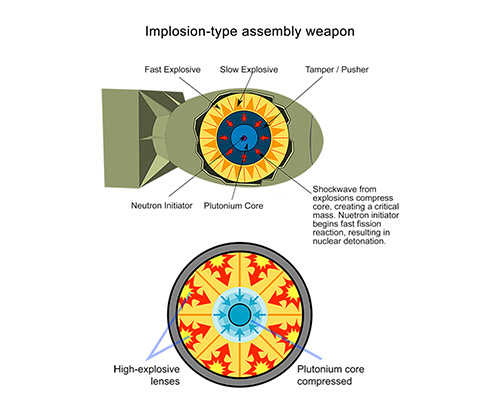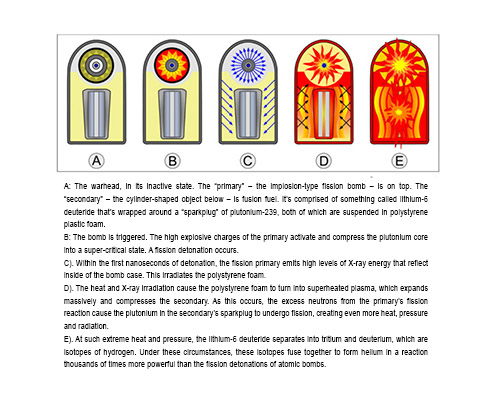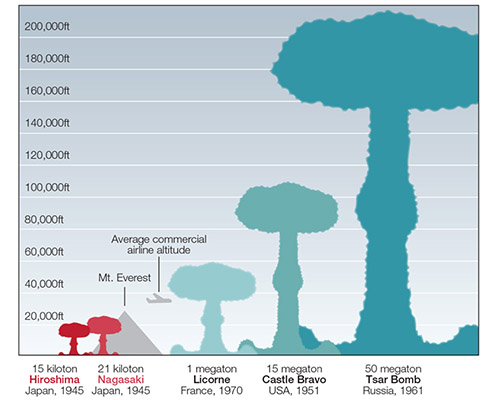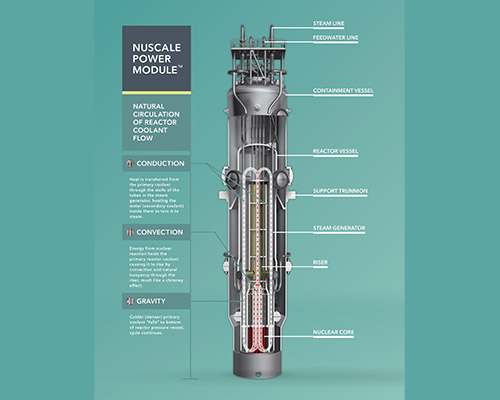The second technology in the Universal Energy framework is thorium - a unique type of nuclear fuel that avoids nearly every complication with our current approach to atomic power.
Unlike uranium - which is enriched and deployed within reactor designs that rely on highly pressurized water[1] - thorium generates energy within a high-temperature liquid inside advanced reactor designs that are not pressurized. These reactors, known as Liquid Fluoride Thorium Reactors (LFTRs), present outstanding capabilities to help build a clean energy future. Here's a short list of their benefits:
- LFTRs are highly efficient – hundreds of times more so than Pressurized Water Reactors.[2]
- LFTRs are extremely safe. Because their fuel and reactant are liquid and not under extreme pressure (unlike today's Pressurized Water Reactors), it is physically impossible for them to "melt down" in a traditional sense.[3]
- Thorium is more stable than other radioactive elements and is safe to handle in raw form unless ingested or inhaled. Additionally, it does not require additional enrichment to power a reactor - a primary pathway to weaponization.[4]
- LFTRs produce far less waste than Pressurized Water Reactors and can also consume both nuclear waste and weapons-grade nuclear material as fuel.[5] Of what small amounts of waste remain, it takes only decades for it to become inert as opposed to millennia with reactors powered by enriched uranium.[6]
- The LFTR’s thorium fuel supply is highly abundant – thorium is about as common as lead – making it thousands of times more plentiful than fuel-grade uranium (only about 0.7% of all uranium in Earth’s known land reserves).[7]
- The thorium fuel in LFTRs is difficult to weaponize. While theoretically possible, the weapon would be unstable, far weaker than traditional nuclear weapons, and would be significantly less practical for use in conflict.[8]
- As a result of their efficiency and safety, LFTRs can be much smaller than traditional nuclear reactors. Where Pressurized Water Reactors often sit on multi-acre compounds and require large buffer zones in case of emergencies, LFTRs can be around the size of a house or even smaller.[9]
- LFTRs are significantly less expensive to build than Pressurized Water Reactors, and their small size allows them to be mass-produced on assembly lines in a standardized and modular capacity.[10] Thus means nuclear reactors can become compact iterations of a product model as opposed to sprawling, custom-built facilities.[11] The cost savings presented by this capability are immense.
Thorium and its associated reactor designs have been known to atomic science for decades.[12] But the reason we're not using thorium today is because it's practically useless for making militarily-effective nuclear weapons - especially those on the scale of uranium and plutonium that can be easily sourced from traditional, uranium-fueled Pressurized Water Reactors.[13]
As weaponization became an important factor during the Cold War, thorium was shelved in favor of the uranium fuel cycle that dominates present-day nuclear power,[14] especially since it's a critical component to making plutonium, and, consequently, hydrogen bombs.[15] As a result, Earth now remains home to some 14,000 nuclear weapons in the hands of at least nine countries that dwarf the destructive potential of the bombs dropped on Hiroshima and Nagasaki.[16] That's more than four for every city on the planet.[17]
Thorium enables us to stop participating in this state of affairs and shift our approach to atomic energy by embracing its unrivaled potential for clean power generation. The reactor designs that leverage thorium can serve this role on a base-load scale nationwide,[18] meaning they can provide continuous, non-intermittent power at all times - regardless of energy demand. In doing so, thorium can function as an energy backbone to help support and extend the power generated by municipally integrated renewables. This becomes especially important in that context, as the immense source of clean energy generated by thorium further allows us to both manufacture and recycle renewables in a carbon-neutral capacity - meaning that the past ecological challenges of their production would no longer apply.
Today, the large-scale production of renewable energy technologies carries massive requirements for materials - more than 10,000 metric tons per terawatt-hour generated.[19] The carbon emissions involved in every step of the renewable supply chain (extraction, transportation, processing, manufacturing, installing, decommissioning, disposing / recycling) are extensive, and carry significant economic and environmental consequences that are often not considered when looking to renewables as a viable energy source.[20] But with thorium, we can manufacture and recycle renewables in a way that's truly clean.
Thorium reactors also generate lots of clean heat that can be used for the synthetic production of vital resources, desalinating fresh water from seawater, and hydrogen fuel thereafter. This provides a cogenerative resource production method as as an inexpensive byproduct of clean power generation. At a large scale, this enables us to desalinate so much fresh water that we can not only solve drought nationwide, but also use our desalinated fresh water supply as a massive battery through The National Aqueduct to store energy generated from renewables.
The result? A massive abundance of clean electricity, fresh water and hydrogen fuel that dramatically amplifies the volume of energy available to society, while at the same time lowering costs of both electricity and the critical resources of water and fuel.
Because thorium reactors can be built to small size, they are ideal complements to and replacements for the small modular uranium reactors being designed and produced today. Because Small Modular Reactors can be built on assembly lines in a modular and standardized capacity, their future adoption of the thorium fuel cycle extends our society's capability to rapidly deploy advanced, clean energy anywhere in the world. This becomes useful not only for traditional power generation, but also for supplemental resource production, atmospheric scrubbing of greenhouse gasses and even methods to clean trash from oceans.








